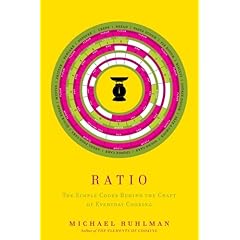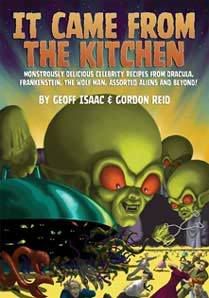
If there is a secret to cooking just about anything, Michael Ruhlman's new book Ratio: The Simple Codes Behind the Craft of Everyday Cooking might have the answer the foodie has been looking for. He sums it up pretty well in this interview with the Globe and Mail.
A ratio is a fixed proportion of ingredients relative to another, and these proportions form the backbone of the culinary arts. A recipe is a specific set of measurements and instructions for combining those measured ingredients. These ratios are starting points.
There are recipes in the book however but Ruhlman is aware of the irony of that. The recipes are very simple and form a basis for more complex recipes. If you know the basic ratio of ingredients (fat, flour and sugar) in a cookie dough, Ruhlman argues that it empowers the cook to create any number cookie recipes.
He also talks about the usefulness of using mass measurements instead of volume. That might explain some of those heavy, dry cakes I've had to suffer through in the past.
It's critical. Ratios don't work with volume, which is why most recipes don't always double well. Flour, depending on the humidity in the air and how long it's been sitting in its sack, weighs anywhere between roughly four and six ounces [per cup]. That means that if a recipe for bread calls for four cups of flour, you could have either sixteen ounces, a pound, or a pound and a half; that's 50 per cent more, and you don't know which one it is. But if you weigh, it's always going to be the same, which is why professional chefs love to use weight.
I've been meaning to buy a scale for some time.




1 comment:
I bought a scale years ago when I had to do a lot of converting from British measurements to U.S., and a lot of my best beloved cookbooks were from Britain.
But I'm stoked about this book, Geoff--sounds like it's right up my alley. I'm trying to get the people who teach maths at my school to start including more real-life lessons with practical applications. Since we have an international school of culinary arts attached to us, this would be good for them.
But I think it would also be really helpful for people like me; because of my recent hospital adventures, I'm going to be consumed by my INR (International Normalized Ratio) for warfarin (the anticoagulant I'll be on for the rest of my life). I'm going to have to understand basic interactions among foods and ingredients, and if I were a believer in more than karma, I'd think you'd been sent by the gods.
Thanks!
Now where's that special recipe? I'd love to share it on the Valve Replacement Forum. You'll be inundated with fans.
Post a Comment